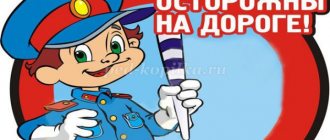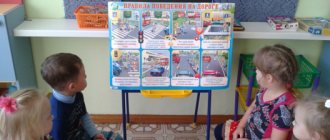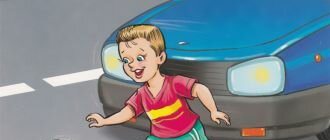Traffic rules quiz
- On the back of the bus/trolleybus there is an inscription: “Skid - 1 m” or “Danger when turning.” What is its significance?
(The above vehicles may lose control while turning, putting the lives of nearby passersby at risk.)
- What is the threat from bushes and trees planted along the edges of streets?
(They limit the view of the street and the movement of vehicles; a pedestrian may not notice a car that suddenly leaves from behind the plantings).
- How to move near the road if there is no sidewalk?
(If there is no sidewalk (for example, in the suburbs), you should move along the side of the road, on the left side, so that traffic moving in the oncoming lane is clearly visible).
- Why should you be wary of vehicles with trailers?
(Because when a car turns, the trailer can skid, hitting one of the pedestrians; an absent-minded passerby, deciding that the car has already passed, will begin to cross the highway and fall under the trailer).
- What is the braking distance of a car if the driver reacts instantly?
(Depends on the current speed, on average - 10-20 m).
- Why does a pedestrian need to be vigilant when cars moving towards each other are nearby?
(A car moving on one side passes another car, and at this moment the driver and the passer-by do not notice each other).
Rules
- Where is it unsafe to cross the road - at a street intersection or near a bus stop?
(Both of these areas are potentially risky to cross. However, stopping is considered more unpredictable, especially for children.
- After getting off the bus, the child hurries to cross the road as quickly as possible, going around it in front or behind. At the same time, it does not focus on a car driving around a bus or moving in the oncoming lane.
- Trying not to be late for a bus that has arrived at a stop on the opposite side, the child will not notice the car on the road, which can lead to an accident.
- In unfavorable weather conditions, a braking bus may lose control and hit passers-by at the stop.
- When passengers enter and exit the bus, there is a chance that the one who hesitates will be crushed by the closing door).
- Can a car driver see a pedestrian every time he approaches him?
( No. The driver must not lose sight of both passers-by on the sidewalks and at pedestrian crossings, as well as other drivers. It is extremely unsafe for a pedestrian to cross the road at dusk - if caught in the headlights of 2 cars moving towards him, it is almost impossible to see him.
- What factors cause the greatest difficulties for driving and crossing roads in the city?
(There are several such factors:
- It is quite difficult to see a small passenger car or moped in advance, since the roadway is “full” of trucks, buses, etc. When stopping or moving, they hide small transport objects.
- The roadway of the street is sometimes planted on the sides with trees and shrubs; nearby there are fences, billboards, buildings built close to the road - all this reduces the view of the street).
- The greatest dangers lie near the roadway.
(A car moving at high speed is unsafe, but passenger cars or larger transport objects that are not moving pose no less of a threat: a stationary car can obscure another car that is in motion and inaccessible to the pedestrian’s view; without paying attention to it , the passer-by believes that there is no threat and crosses the road, falling under the wheels of a car).
For children
- a Zebra sign give any privileges to a passer-by to cross the roadway?
(No, this sign only indicates to the passer-by a place where it is not prohibited to cross the roadway. On a zebra crossing, where there is no traffic control, passers-by are allowed to enter the roadway only after first assessing how far it is to the approaching vehicle , how fast it is going and making sure that it is safe to cross the street).
Pedestrian traffic
Another traffic rules quiz with answers:
- Who is a pedestrian? A pedestrian is a person who moves on foot.
- What areas are designated for pedestrian traffic? For the movement of pedestrians, a sidewalk and a pedestrian path are provided; if there is no zone for pedestrian movement, movement along the roadway is possible, but always in the direction opposite to the traffic flow.
- What is a sidewalk for? For pedestrian traffic.
- What is a roadway? Part of the road for transport.
- Types of roads? Roads are one-way or two-way, with left-hand and right-hand traffic directions.
- Rules for crossing the street as a pedestrian? A pedestrian must cross the street in places where there is a traffic light at a green traffic light sign, at a pedestrian crossing, underpass, at a traffic controller sign.
- What is the purpose of a traffic light? The traffic light is designed to regulate the movement of vehicles and pedestrians.
- Crossroads is...? A crossroads is an intersection of roads.
Blitz questionnaire on traffic rules
- A vehicle on four wheels that can move independently. (Car).
- The name of horse-drawn transport used in ancient times. (Coach).
- How can you transport more passengers than a car? (By bus).
- A favorite vehicle for active boys, they ride it by pushing off with their feet. (Scooter).
- A car that can move even on the worst roads. (SUV).
- "House" for the car. (Garage).
- A place where planes stay between flights. (Hangar).
- Passerby walking along the sidewalk. (A pedestrian).
- The name of the alley in the middle of the street. (Boulevard).
- Where do the trams go? (On the rails).
For children - A road section intended for pedestrian movement. (Sidewalk).
- Who is driving the car? (Driver).
- Who flies the plane? (Pilot, pilot).
- What can you use to stop a car? (Brakes).
- The name of the striped markings for pedestrians. (Zebra).
- Where do the streets intersect? (At the crossroads).
- What do special vehicles use to honk loudly: ambulance, fire, police? (With the help of a siren).
- A place where pedestrians become passengers on public transport or disembark from it. (Stop).
- Reliable wide fabric stripes that can reduce the danger for the driver and passengers in a passenger car. (Seat belts) .
- What does a motorcyclist wear on his head to protect it from injury? (Helmet) .
- What do you call a passenger who likes to travel without a ticket? (Hare).
- A single name for large vehicles of various types that transport a large number of citizens. (Public transport).
- What do you call someone who rides in a vehicle but is not behind the wheel? (Passenger).
- Ticket seller in public transport. (Conductor).
- Public transport running underground. (Metropolitan).
- Mobile staircase in the underground. (Escalator).
- Where is the driver of a car, bus, trolleybus, tram. (In the cockpit).
- A sports facility where circuit cycling races are held. (Cycle track).
- What is the name of the area where the railway tracks intersect with the highway? (Moving).
- The name of the crossbar that opens and closes the railway crossing. (Barrier).
- What do the rails rest on? (On the sleepers).
- A road outside the city, covered with asphalt, along which vehicles move. (Highway).
- A ditch for drainage of water located along the road. (Ditch).
- What does a car use to move? (Using wheels).
- How does a driver see the road in the dark? (Turns on headlights).
- The name of the part of the truck in which goods are transported. (Body).
- A truck whose body can dump its own cargo. (Dump truck).
- The motor is hidden under this cover. (Hood).
For children - How can you tow a car? (Using a cable).
- The name of the underground structure through which vehicles move. (Tunnel).
- The name of the car coincides with the name of a large river in Russia. (Volga).
- What do you call a pedestrian or driver who does not follow traffic rules? (Violators).
- How are traffic violators punished? (They charge a fine).
Rules of conduct on the road
A traffic rules quiz for schoolchildren should form stable concepts in this area. What is the essence of the concept of traffic rules and their necessity? Rules of conduct on the road are instructions for the actions of all road users. Ignorance of basic nuances leads to road accidents, injuries and deaths.
Everyone should know the answers to the following questions:
- What are the main sections of traffic rules? Responsibilities and rights of passengers, pedestrians and drivers, requirements for cyclists, speed, overtaking rules. Traffic regulation, stopping, parking, road signs, and road markings should also be studied.
- What kind of vehicle traffic is established on the territory of the former Soviet Union? Right-hand traffic of vehicles.
- On which side are vehicles overtaken? Overtaking is done on the left.
The proposed traffic rules quiz for schoolchildren motivates the need for students to study the rules of conduct.
Rules for public transport passengers
An important topic is consideration of the rules of conduct for passengers in public transport.
A traffic rules quiz may include the following questions:
- What places are available to wait for public transport? Landing areas are equipped to wait for public transport; if they are not available, a sidewalk or the side of the road is used.
- Rules for boarding and disembarking passengers on trams, trolleybuses, and buses. Boarding is carried out through the rear doors, and disembarking is through the front doors. Preferential categories of the population can enter through the front doors.
- Which direction should a passenger exiting a tram look in order to cross the road safely? You must look to the right to make sure there is no other traffic.
- Is it possible for a passenger exiting public transport to walk around in front or behind it? Bypassing vehicles is dangerous to life; crossing is possible only in the designated place.
- Is it possible for a passenger to distract a public transport driver while driving? Distracting the driver while driving is strictly prohibited.
Road and cyclists
A separate issue that needs to be discussed among schoolchildren is compliance with traffic rules by persons driving bicycles and mopeds, since most of the children drive one of these vehicles.
A traffic rules quiz may include the following questions:
- Age of owners of mopeds and bicycles, from which it is permitted to drive these vehicles on the roadway? (For mopeds – 16 years, bicycles – 14 years).
- What categories of passengers can a person driving a moped or bicycle transport? (Children under seven years of age).
- Rules for movement on sidewalks and pedestrian paths for persons driving a moped or bicycle? Children are allowed to travel on sidewalks and pedestrian paths on children's bicycles under the supervision of adults.
- Equipment requirements for mopeds and bicycles? Availability of lighting, sound signal, reflectors (white in front, orange on the side, red in the back), working brakes.






